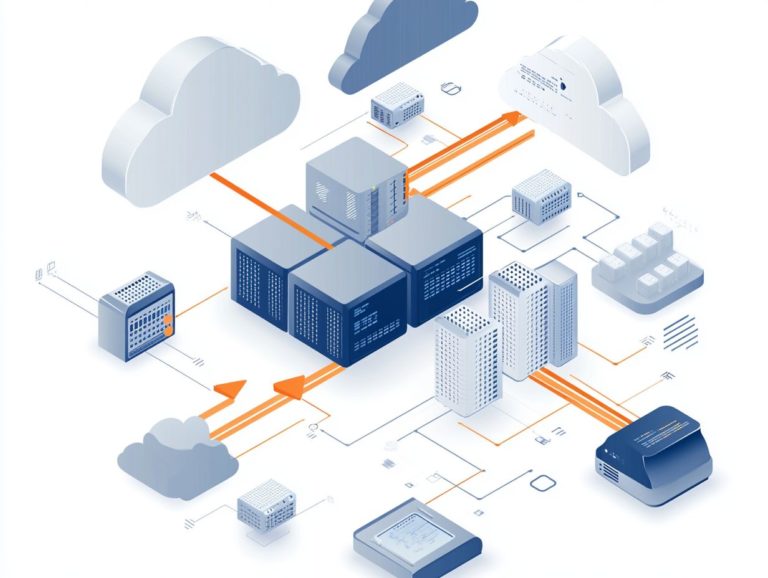The Importance of SLAs in IaaS
In the fast-changing world of Infrastructure as a Service (IaaS), Service Level Agreements (SLAs) are crucial. They set clear expectations and responsibilities between service providers and clients.
Understanding SLAs is vital for building trust and accountability in cloud services. Let s dive deep into SLAs to unlock the full potential of your IaaS experience.
Contents
- Key Takeaways:
- Understanding SLAs in IaaS
- Key Components of an SLA
- Benefits of SLAs in IaaS
- Common Issues with SLAs in IaaS
- Best Practices for Implementing and Managing SLAs
- Frequently Asked Questions
- What is an SLA in IaaS and why is it important?
- What are the key components of a Service Level Agreement (SLA) in Infrastructure as a Service (IaaS)?
- What are the benefits of having an SLA for IaaS?
- How do SLAs in IaaS differ from traditional IT service level agreements?
- What happens if the service provider fails to meet the SLA terms?
- How can customers ensure they receive the promised service levels outlined in the SLA?
Key Takeaways:

SLAs in IaaS are essential for ensuring reliability and accountability.
Key components include Service Level Objectives (SLOs), performance guarantees, and service credits.
Establish realistic expectations, monitor performance, and address issues promptly.
Understanding SLAs in IaaS
SLAs within IaaS are essential for any business using cloud technologies. They outline the expectations and responsibilities of service providers like Oracle Cloud, helping to clarify what cloud SLAs are.
SLAs include performance metrics, data ownership, and compliance rules. This framework not only clarifies expectations but also supports business continuity and cybersecurity.
What are SLAs and Why are They Important?
SLAs are formal contracts that specify expected service levels, including performance metrics and response times. These documents are crucial for managing commitments and expectations.
In cloud services, defining these parameters is critical. They clarify what to expect in terms of uptime and reliability, as well as how service interruptions will be addressed.
Effective SLAs detail support mechanisms, fostering accountability and setting performance benchmarks. This transparency helps tackle issues proactively, strengthening your relationship with the provider.
Key Components of an SLA
Key components of an SLA include service level objectives (SLOs), performance guarantees, service credits, and well-defined service levels. These elements provide clarity and assurance in your business relationships.
Service Level Objectives (SLOs)
SLOs are measurable goals that a service provider commits to achieving. They can include maintaining a specific level of service availability and minimizing error rates.
Setting and monitoring these objectives creates clear expectations for both parties. For example, an SLO might state that a cloud service must be available 99.9% of the time, which means no more than 40 minutes of downtime each month.
Reviewing these objectives regularly helps identify areas for improvement and ensures the service meets or exceeds expectations.
Service Level Agreements (SLAs)

Service Level Agreements (SLAs) describe the agreed-upon terms for service delivery. They detail measurable standards of service, service levels, and compliance regulations to ensure both parties fulfill their obligations.
These documents serve as blueprints that clarify expectations and responsibilities. They illuminate the operational dynamics between the parties involved.
By establishing measurable standards of service and outlining penalties for non-compliance, SLAs protect your interests. They also provide a framework for service providers to manage their offerings effectively.
Understanding the intricacies of SLAs is crucial for any organization. Aligning expectations helps pinpoint areas for improvement and cultivates a healthy, productive relationship between service entities and clients.
Service Level Guarantees (SLGs)
Service Level Guarantees (SLGs) offer assurances about performance standards like uptime percentages and service availability. They also outline consequences for failing to meet these guarantees, typically in the form of service credits or discounts.
These frameworks create clear expectations and act as a safety net. They ensure you have recourse in case of service interruptions or failures.
By defining compensation mechanisms, SLGs build trust and accountability. They compel service providers to maintain consistent performance.
SLGs encourage providers to minimize downtime and address issues swiftly. This proactive approach safeguards your interests, promoting a reliable service ecosystem.
Benefits of SLAs in IaaS
Implementing SLAs in IaaS offers numerous benefits, particularly enhancing the reliability and availability of cloud services, as well as understanding SLA differences among cloud providers.
It also fosters transparency and accountability between service providers and customers. This leads to a more seamless and trustworthy experience for everyone involved.
Ensuring Reliability and Availability
SLAs are key to ensuring the reliability and availability of cloud services. They set clear performance metrics for service providers to follow, helping minimize disruptions.
These agreements define various benchmarks, including uptime percentages and response times. For instance, an uptime guarantee of 99.9% means downtime beyond this threshold could lead to penalties for the provider.
Businesses relying on cloud solutions risk vulnerabilities if these metrics aren t met. This can impact operations and customer satisfaction.
Thus, understanding SLAs safeguards your interests and cultivates strong partnerships with service providers.
Providing Transparency and Accountability
SLAs create a transparent framework by defining expectations for both you and the service provider. This ensures agreements are upheld, and you re informed of potential service issues promptly.
This clarity helps you know what to expect in terms of service quality and response times. For example, specific uptime guarantees from an internet service provider give you peace of mind.
Regular reports on performance metrics keep you engaged and informed. Such updates signal that the service provider values your business.
This proactive communication reinforces trust and fosters long-term relationships built on reliability and mutual respect.
Common Issues with SLAs in IaaS

Common issues with SLAs in IaaS include challenges in measuring and enforcing agreements. Breaches can lead to service interruptions and customer dissatisfaction.
Challenges in Measuring and Enforcing SLAs
Measuring and enforcing SLAs (Service Level Agreements) can present quite a challenge. This is especially true when defining and quantifying performance metrics that genuinely reflect service levels and accountability.
These complexities often stem from varying methods of data collection and the interpretation of vague terms. Additionally, real-time monitoring is often required to ensure compliance. Your organization may grapple with the task of bringing together data from different sources, which can result in discrepancies in performance evaluations.
To enhance measurement accuracy, it s vital to implement robust tracking tools and standardized protocols for data reporting.
Establishing clear enforcement mechanisms, such as predetermined penalties for non-compliance, will drive service providers to meet the agreed-upon standards and foster a culture of accountability.
Dealing with Breaches of SLAs
Addressing breaches of SLAs effectively is essential for maintaining service quality. These breaches can lead to service interruptions and may require implementing service credits or remedial actions.
When an SLA breach occurs, the first step should be to promptly inform your customers about the issue, ensuring transparency. This communication must outline the reasons for the breach and the anticipated impact on service delivery.
Next, it’s vital to devise remediation strategies tailored to the specific circumstances. This might involve adjusting workloads, reallocating resources, or enhancing system monitoring.
Implementing service credits is a vital aspect of your response. These not only compensate affected customers but also help restore trust and demonstrate your commitment to high standards. Regular follow-ups will reinforce confidence in your accountability and dedication to continuous improvement.
Best Practices for Implementing and Managing SLAs
Adopting best practices for implementing and managing SLAs is essential to ensure that both parties maintain clear expectations. This approach guarantees that the agreements remain relevant and effective over time.
Establishing Clear and Realistic Expectations
Establishing clear and realistic expectations in SLA agreements is crucial. It aligns your SLAs with the actual capabilities and service levels of your provider.
By doing this, you can cultivate a productive partnership that meets your operational needs while harmonizing with the provider’s resources and competencies.
Engaging in open dialogues during the development of these agreements is essential. Both you and the provider must understand your respective responsibilities and limitations.
This collaborative approach reduces the risk of discrepancies in service quality and enhances customer satisfaction by delivering on promises.
Ultimately, well-defined SLAs serve as the foundation for effective communication and a shared vision both of which are vital for achieving long-term success.
Regularly Monitoring and Reviewing SLAs

Regularly monitoring and reviewing SLAs is crucial for maintaining compliance with performance parameters while also adapting to the evolving needs of your business.
This proactive approach enables you to pinpoint potential gaps in service delivery before they escalate into significant issues.
Effectively tracking service metrics means not just collecting quantitative data but also engaging with qualitative feedback from your stakeholders.
By establishing clear benchmarks and employing automated tools for real-time analysis, you can swiftly recognize trends and address any performance shortfalls.
Creating a feedback loop allows your teams to make timely adjustments, ultimately nurturing a culture of continuous improvement that aligns your services more closely with your organizational objectives.
Frequently Asked Questions
What is an SLA in IaaS and why is it important?
An SLA, or Service Level Agreement, is a contract between a service provider and a customer that outlines the level of service expected. In the context of IaaS, an SLA is important because it sets expectations for the reliability, availability, and performance of the services provided.
To ensure your SLAs are effective, consider reviewing them regularly and reaching out for more information if needed.
What are the key components of a Service Level Agreement (SLA) in Infrastructure as a Service (IaaS)?
The key components of an SLA in IaaS typically include metrics for uptime, response time, and service availability. It may also provide details about data backups, disaster recovery, and security measures.
What are the benefits of having an SLA for IaaS?
Having an SLA in place for IaaS ensures that the service provider and customer share the same expectations. It provides a framework for resolving issues or disputes that may arise and highlights the importance of vendor lock-in in IaaS. This can also improve the quality and reliability of the services offered.
How do SLAs in IaaS differ from traditional IT service level agreements?
SLAs in IaaS focus specifically on cloud-based services. They tend to be more dynamic and flexible because cloud services can change rapidly.
What happens if the service provider fails to meet the SLA terms?
If the service provider fails to meet the SLA terms, the customer may be entitled to compensation, such as service credits or refunds. Both parties should clearly understand the consequences of not meeting the agreed-upon service levels.
How can customers ensure they receive the promised service levels outlined in the SLA?
To ensure they receive the promised service levels, customers can regularly monitor the service metrics outlined in the SLA. They should also communicate with the service provider to address any concerns or issues.






